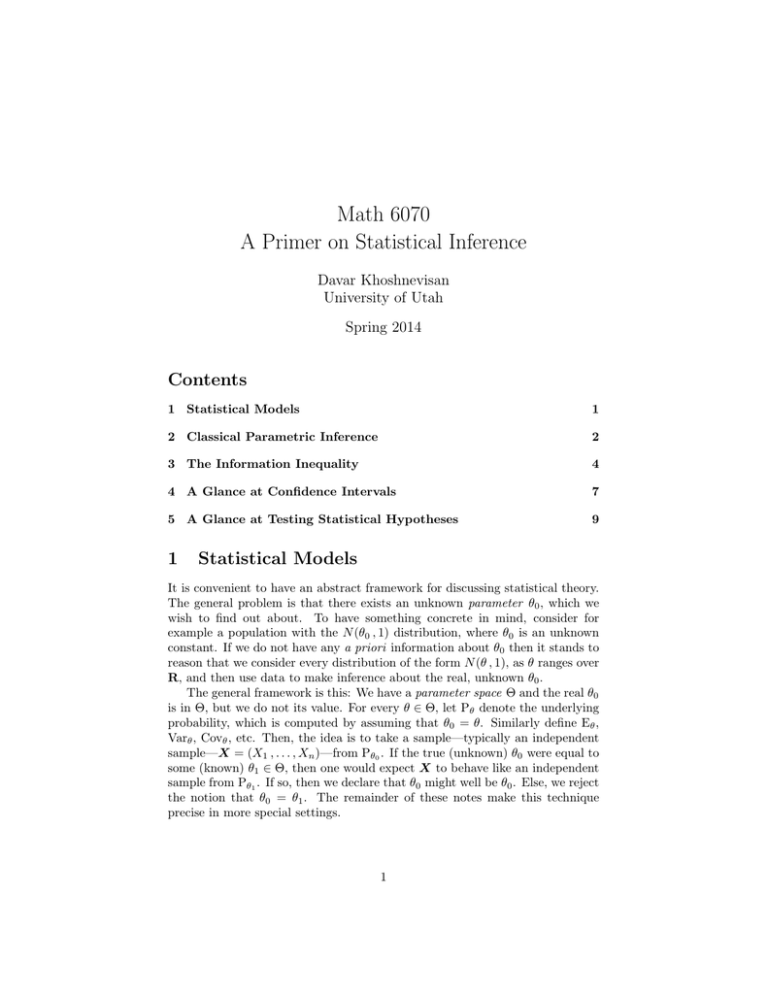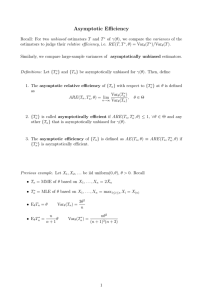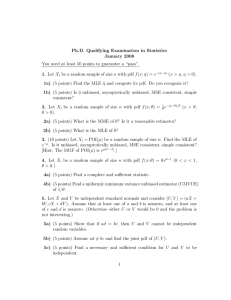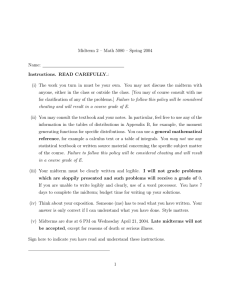Math 6070 A Primer on Statistical Inference Contents Davar Khoshnevisan
advertisement

Math 6070
A Primer on Statistical Inference
Davar Khoshnevisan
University of Utah
Spring 2014
Contents
1 Statistical Models
1
2 Classical Parametric Inference
2
3 The Information Inequality
4
4 A Glance at Confidence Intervals
7
5 A Glance at Testing Statistical Hypotheses
9
1
Statistical Models
It is convenient to have an abstract framework for discussing statistical theory.
The general problem is that there exists an unknown parameter θ0 , which we
wish to find out about. To have something concrete in mind, consider for
example a population with the N (θ0 , 1) distribution, where θ0 is an unknown
constant. If we do not have any a priori information about θ0 then it stands to
reason that we consider every distribution of the form N (θ , 1), as θ ranges over
R, and then use data to make inference about the real, unknown θ0 .
The general framework is this: We have a parameter space Θ and the real θ0
is in Θ, but we do not its value. For every θ ∈ Θ, let Pθ denote the underlying
probability, which is computed by assuming that θ0 = θ. Similarly define Eθ ,
Varθ , Covθ , etc. Then, the idea is to take a sample—typically an independent
sample—X = (X1 , . . . , Xn )—from Pθ0 . If the true (unknown) θ0 were equal to
some (known) θ1 ∈ Θ, then one would expect X to behave like an independent
sample from Pθ1 . If so, then we declare that θ0 might well be θ0 . Else, we reject
the notion that θ0 = θ1 . The remainder of these notes make this technique
precise in more special settings.
1
2
Classical Parametric Inference
The typical problem of classical statistics is the following: Given a family of
probability densities {fθ }θ∈Θ how can we decide whether or not ours is fθ ? More
precisely, we have an unknown density fθ0 ; we wish to estimate it by choosing
one from the family {fθ }θ∈Θ of densities available to us. [Alternatively, you
could replace fθ by a mass function pθ .] Here, Θ is the “parameter space,” and
θ0 is the unknown “parameter.”
To estimate θ0 one typically considers an independent sample X1 , . . . , Xn
from the true distribution with density fθ0 , and constructs an estimator θ̂.
Example 1 Let Θ := R, and fθ the N (θ , 1) density. The standard approach
is to estimate θ0 with
X1 + · · · + Xn
.
(1)
θ̂ :=
n
There are many reasons why θ̂ is a good estimate of θ.
1. [Unbiasedness] Evidently,
for all θ ∈ Θ.
Eθ (θ̂) = θ,
(2)
This is called unbiasedness. In general, a random variable T is said to be
an unbiased estimator of θ if Eθ (T ) = θ for all θ ∈ Θ.
2. [Consistency] By the law of large numbers, for all θ ∈ Θ,
P
θ̂ →θ θ
as n → ∞.
(3)
This is called consistency. In general, a random variable T is said to be a
P
consistent estimator of θ0 if T →θ θ for all θ ∈ Θ as the sample size tends
to infinity.
3. [MLE] The maximum likelihood estimate of θ0 —in all cases–is an estimator that maximizes θ 7→ fθ (X1 . . . , Xn ) for an independent sample
(X1 , . . . , Xn ), where fθ here represents the joint density function of n
i.i.d. random variables each with density N (θ , 1). In the present example.
n
X
1
1
fθ (X1 , . . . , Xn ) =
exp −
(Xj − θ)2 .
(4)
2 j=1
(2π)n/2
To find a MLE, it is easier to maximize the log likelihood,
L(θ) := ln fθ (X1 , . . . , Xn ),
(5)
Pn
which is the same as minimizing h(θ) := j=1 (Xj − θ)2 over all θ. But
P
n
h0 (θ) = −2 j=1 (Xj − θ) and h00 (θ) = 2n > 0. Therefore, the MLE is
uniquely θ̂.
2
The statistics θ̂ has other optimality features too. See for instance Example 8
(page 7) below.
Example 2 Suppose Θ := R×(0 , ∞). Then, we can write θ ∈ Θ as θ = (µ , σ 2 )
where µ ∈ R and σ > 0. Suppose fθ is the N (µ , σ 2 ) density. Then the usual
estimator for the true parameter θ0 = (µ0 , σ02 ) is θ̂ := (µ̂ , σ̂ 2 ), where
n
µ̂ :=
1X
Xj ,
n j=1
(6)
n
1X
σ̂ :=
(Xj − µ̂)2 .
n j=1
2
[As before, X1 , . . . , Xn is an independent sample.] As in the previous example,
θ̂ is the unique MLE, and is consistent. However, it is not unbiased. Indeed,
µ
,
for all θ = (µ , σ 2 ) ∈ Θ.
(7)
Eθ (θ̂) = 2
1 − n1 σ 2
So θ̂ is “biased,” although it is asymptotically unbiased ; i.e., Eθ (θ̂) → θ as
n → ∞.
Example 3 Suppose Θ = (0 , ∞), and fθ is the uniform-(0 , θ) density for all
θ ∈ Θ. Given an independent sample X1 , . . . , Xn , we consider
θ̂ := max Xj .
(8)
1≤j≤n
The distribution of θ̂ is easily computed, viz.,
o
n
n
Pθ θ̂ ≤ a = [Pθ {X1 ≤ a}] = (a/θ0 )n ,
0 ≤ a ≤ θ0 .
(9)
This gives the density fθ̂ (a) = nθ0−n an−1 for 0 ≤ a ≤ θ0 . Consequently,
Eθ (θ̂) =
θ0−n
Z
θ0
nan da =
0
nθ0
.
n+1
(10)
Therefore: (i) θ̂ is biased; but (ii) it is asymptotically unbiased. Next we show
that θ̂ is consistent. Note that θ̂ ≤ θ0 , by force. So it is enough to show that
with high probability θ̂ is not too much smaller than θ0 . Fix > 0, and note
that
n
o Z (1−)θ0
Pθ θ̂ ≤ (1 − )θ0 =
nθ0−n an−1 da = (1 − )n .
(11)
0
Thus,
(
)
θ̂
Pθ − 1 > ≤ 1 − (1 − )n → 0.
θ0
3
(12)
That is, θ̂ is consistent, as asserted earlier. To complete the example let us
compute the MLE for θ0 . Evidently,
fθ (X1 , . . . , Xn ) =
1
I{θ > θ̂},
θn
(13)
where I{A} is the indicator of A. So to find the MLE we observe that I{A} ≤ 1,
so that fθ (X1 , . . . , Xn ) ≤ 1/θ̂n . The MLE is θ̂ uniquely.
One can consider a variant of θ̂, here, that is unbiased and consistent, but
only “approximately” MLE for large n. Namely, we can consider the statistic
θ̃ := (n + 1) max1≤j≤n Xj /n = (1 + n1 ) max1≤j≤n Xj .
3
The Information Inequality
Let us concentrate on the case where every θ ∈ Θ is one-dimensional, and hence
so is θ0 .
Let X := (X1 , . . . , Xn ) be a random vector with joint density fθ (x). The
Fisher information of the family {fθ }θ∈Θ is defined as the function I(θ), where
"
2 #
∂
ln fθ (X)
,
(θ ∈ Θ),
(14)
I(θ) := Eθ
∂θ
provided that the expectation exists and is finite. If X is discrete we define I(θ)
in the same way, but replace fθ by the joint mass function pθ .
In the continuous case, for example, the Fisher information is computed as
follows:
2
Z ∞
Z ∞
∂
I(θ) =
···
ln fθ (x) fθ (x) dx
∂θ
−∞
−∞
(15)
2
Z ∞
Z ∞
1
∂
=
···
fθ (x)
dx.
∂θ
−∞
−∞ fθ (x)
So in fact I(θ) is always defined, but could be any number in [0 , ∞].
Example 4 In the case of independent N (θ , 1)’s,
n
ln fθ (x) = −
n
1X
ln(2π) −
(xj − θ)2 .
2
2 j=1
Pn
− θ). Therefore,
2
n
n
X
X
I(θ) = Eθ
Xj − nθ = Varθ
Xj = n.
The θ-derivative is
(16)
j=1 (xj
j=1
j=1
[Here it does not depend on θ.]
4
(17)
Example 5 Suppose X1 , . . . , Xn ∼ Poisson(θ) are independent, where θ ∈
Θ := (0 , ∞). [Remember that “Y ∼ D” means that “Y is distributed as
D.”] Now we have the joint mass function pθ (x) instead of densities. Then,
ln pθ (x) = −nθ + ln θ
n
X
xj −
j=1
n
X
ln(xj !).
(18)
j=1
Differentiate with respect to θ in order to obtain
n
1X
∂
ln pθ (x) = −n +
xj .
∂θ
θ j=1
(19)
2
Pn
n
Var( j=1 Xj )
n
1 X
Xj − nθ =
= .
I(θ) = 2 E
2
θ
θ
θ
j=1
(20)
Therefore,
The following is due to Fréchét originally, and was rediscovered independently, and later on, by Crámer and Rao.
Theorem 6 (The Information Inequality) Suppose T is a non-random function of n variables. Then, under “mild regularity conditions,”
2
Varθ (T (X)) ≥
[h0 (θ)]
,
I(θ)
(21)
for all θ, where h(θ) := Eθ [T (X)].
The regularity conditions are indeed mild; they guarantee that certain integrals and derivatives commute. See (24) and (27) below.
The proof requires the following form of the Cauchy–Schwarz inequality:
Lemma 7 (Cauchy–Schwarz Inequality) For all rv’s X and Y ,
|Cov(X , Y )|2 ≤ Var(X) · Var(Y ),
(22)
provided that all the terms inside the expectations are integrable.
p
p
Proof. Let X 0 := (X − EX)/ Var(X) and Y 0 := (Y − EY )/ Var(Y ). Then,
h
i
2
0 ≤ E (X 0 − Y 0 ) = E[(X 0 )2 ] + E[(Y 0 )2 ] − 2E[X 0 Y 0 ]
"
#
(23)
Cov(X , Y )
=2 1− p
.
Var(X) · Var(Y )
5
This proves the result when Cov(X , Y ) ≥ 0. When Cov(X , Y ) < 0, we consider
instead E[(X 0 + Y 0 )2 ].
Proof of the Information Inequality in the Continuous Case. Note that
if fθ is nice then
Z ∞
Z ∞
Z ∞
Z ∞
∂
∂
···
fθ (x) dx = 0.
(24)
···
fθ (x) dx =
∂θ −∞
−∞
−∞
−∞ ∂θ
This is so simply because [· · · ] = 1. Therefore,
Z ∞
∂
∂
Eθ
ln fθ (X) =
fθ (x) ln fθ (x) dx = 0.
∂θ
∂θ
−∞
(25)
This proves that
I(θ) = Varθ
∂
ln fθ (X) .
∂θ
Similarly, if things are nice then
Z ∞
Z ∞
∂
∂
···
T (x) fθ (x) dx
Eθ T (X) ln fθ (X) =
∂θ
∂θ
−∞
−∞
Z ∞
Z ∞
∂
=
···
T (x)fθ (x) dx
∂θ −∞
−∞
∂
Eθ [T (X)] = h0 (θ).
=
∂θ
Combine (24) and (27) to find that
∂
Covθ T (X) ,
ln fθ (X) = h0 (θ).
∂θ
(26)
(27)
(28)
Thanks to Lemma 7,
0
2
|h (θ)| ≤ Varθ (T (X)) · Varθ
∂
ln fθ (X) = Varθ (T (X)) · I(θ).
∂θ
See (26). This proves the information inequality.
(29)
A useful consequence of the information inequality is that, under mild conditions, any unbiased estimator T (X) has the property that
Varθ (T (X)) ≥
1
.
I(θ)
(30)
This leads to the notion of MVU estimators: These are unbiased estimators
that have minimum variance. Thanks to (30), if we can find a function T such
that Var(T (X)) = 1/I(θ0 ), then we have found an MVU estimator of θ.
6
Example 8 Suppose X1 , . . . , Xn are i.i.d. N (θ , 1)’s. Let T be such that T (X)
is an unbiased estimator of θ. According to Example 4, I(θ) = n, so that
Varθ (T (X)) ≥ 1/n = Varθ (X̄n ). That is, θ̂ := (X1 +· · ·+Xn )/n has the smallest
variance among all unbiased estimators of θ. This is the “MVU” property.
More precisely, any estimator θ̂ is said to be MVUE when it is a (often, “the”)
minimum variance unbiased estimator of θ0 .
Example 9 Suppose X1 , . . . , Xn are Poisson(θ), where θ > 0 is an unknown
parameter. [The true parameter is some unknown θ0 , so we model it this way.]
Because Eθ (X1 ) = θ, the law of large numbers implies that
X̄n :=
X1 + · · · + Xn Pθ
→ θ.
n
(31)
So, X̄n is a consistent estimator of θ0 . Recall also that Varθ (X1 ) = θ, so that
Varθ (X̄n ) = θ/n. We claim that X̄n is a minimum variance unbiased estimator.
In order to prove it it suffices to show that I(θ) = n/θ. But this was shown to
be the case already; see Example 5 on page 5.
4
A Glance at Confidence Intervals
Choose and fix α ∈ (0 , 1). A confidence set C with level (1 − α) is a random set
that depends on the sample X, and has the property that Pθ {θ ∈ C} ≥ 1 − α
for all θ ∈ Θ. If C varies with n, and limn→∞ Pθ {θ ∈ C} ≥ 1 − α for all θ ∈ Θ,
then we say that C is a confidence interval for θ0 with asymptotic level (1 − α).
Example 10 Consider the model N (θ , 1) where θ ∈ Θ := R. Then, it easy to
see that
X̄n − θ
√ ∼ N (0 , 1) under Pθ .
(32)
1/ n
Here, “Under Pθ ” is short-hand for “If θ were the true parameter, for all θ ∈ Θ.”
Consider the random set
z
z
(33)
C(z) := X̄n − √ , X̄n + √ ,
n
n
where z ≥ 0 is fixed. Then,
z
Pθ {θ ∈ C(z)} = Pθ |X̄n − θ| ≤ √
n
|X̄n − θ|
√
= Pθ
≤z
1/ n
= P{|N (0 , 1)| ≤ z} = 2Φ(z) − 1.
(34)
See (32) for the last identity. Choose z = zα/2 such that 2Φ(zα/2 ) − 1 = 1 − α
to see that Pθ {θ ∈ C(zα/2 )} = 1 − α. That is, C(zα/2 ) is a confidence interval
7
for θ0 with level 1 − α. Note that zα/2 is defined by Φ(zα/2 ) = 1 − (α/2).
The numbers zα/2 are called “normal quantiles,” because P{N (0 , 1) ≤ zα/2 } =
Φ(zα/2 ) = 1 − (α/2).
Example 11 Consider the model Binomial(n , p), where n is a known integer,
but p ∈ [0 , 1] is an unknown constant. Here, Θ = [0 , 1], and every p ∈ Θ is a
parameter. We consider the estimate
p̂ :=
Sn
,
n
(35)
where Sn denotes the total number of successes in n independent samples. Evidently, Sn ∼ Binomial(n , p) under Pp . Therefore, Ep (p̂) = p and Varp (p̂) =
p(1 − p)/n.
By the central limit theorem, as n tends to infinity,
S − np
d
p n
→ N (0 , 1),
np(1 − p)
(36)
under Pp . (Why?) Equivalently,
p̂ − p
d
p
→ N (0 , 1),
p(1 − p)/n
(37)
Pp
under Pp . Also, by the law of large numbers, p̂ → p. (Why?) Apply the latter
two results, via Slutsky’s theorem, to find that under Pp ,
p̂ − p
d
p
→ N (0 , 1).
p̂(1 − p̂)/n
(38)
Now consider
"
Cn (z) := p̂ − z
r
p̂(1 − p̂)
, p̂ + z
n
r
#
p̂(1 − p̂)
.
n
(39)
Then, we have shown that
lim Pp {p ∈ Cn (z)} = P{|N (0 , 1)| ≤ z} = 2Φ(z) − 1.
n→∞
(40)
Therefore, Cn (zα/2 ) is asymptotically a level-(1 − α) confidence interval for p.
There are many variants of confidence intervals that are also useful. For
instance, a one-sided confidence interval is a half-infinite random interval that
should contain the parameter of interest with a pre-described probability. Similarly, there are one-sided confidence intervals that have a given asymptotic
level. Finally, there are higher-dimensional generalizations. For example, there
are confidence ellipsoids, confidence bands, etc. All of them are random sets—
often with a pre-described geometry—that have exact or asymptotic level (1−α)
for a pre-described level α ∈ (0 , 1).
8
5
A Glance at Testing Statistical Hypotheses
Someone proposes the theory that a certain coin is fair. To test this hypothesis,
a statistician can flip the said coin n times, independently. Record the number
of heads Sn . In any event, we know that Sn ∼binomial(n , p) for some p. Thus,
we write the proposed hypothesis as the null hypothesis, H0 : p = 21 , versus the
alternative, H1 : p 6= 12 . If the null hypothesis is correct, then p̂ := Sn /n is close
to p = 1/2 with high probability. Fix α ∈ (0 , 1), and consider the confidence
interval Cn (zα/2 ) from Example 11 on page 8. It is more convenient to write
PH0 here instead of Pp . With this in mind, we know then that for large n,
PH0 p 6∈ Cn (zα/2 ) ≈ α.
(41)
Here is how we make an inference about H0 : If p 6∈ Cn (zα/2 ), then we reject the
null hypothesis H0 . Else, we accept H0 , but only in the sense that we do not
reject it. There are two sources of error in testing statistical hypotheses:
1. Type-I Error: This is the probability of incorrect rejection of H0 . In our
example, (41) shows that the type-I error is asymptotically α.
2. Type-II Error: This is the probability of incorrect acceptance of H1 . In
our example, type-II error is
β = PH1 p ∈ Cn (zα/2 ) ,
(42)
which goes to zero as n → ∞.
A slightly more general parametric testing problem is to decide between
H0 : θ ∈ Θ0 versus H1 : θ ∈ Θ1 , where Θ0 and Θ1 are subsets of Θ. It need
not be the case that Θ0 ∪ Θ1 = Θ, but it must be that Θ0 ∩ Θ1 = ∅. Our
answer is typically found by finding a confidence interval (or set, or . . . ) C of
a predescribed asymptotic level (1 − α) such that PH0 {θ ∈ C} ≈ 1 − α, and
hopefully PH1 {θ ∈ C} is small. If C ∩ Θ0 = ∅ then reject H0 , else accept H1 .
9








